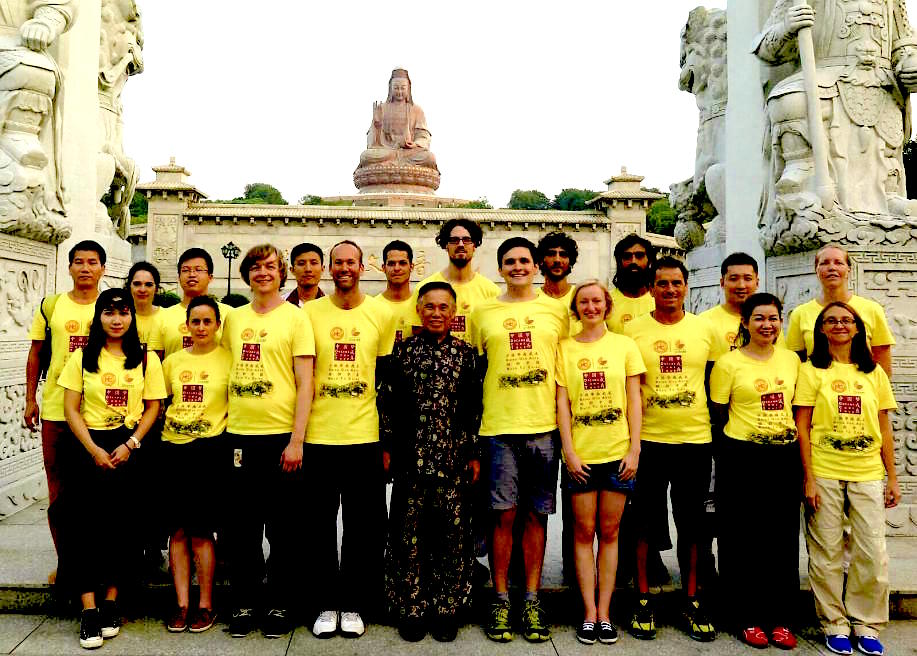TWO-DRAGON MOUNTAIN AND MOUNTAIN OF BUDDHAS

Colourful Windmills amongst Sea of Flowers on Er Long Shan
By courtesy of Tony Lai at https://www.youtube.com/watch?v=lHk485_TgPQ
The trip to China from 20th to 29th September 2016 was very memorable.. Besides having the courses at the majestic Er Long Shan, or Two-Dragon Mountain in Gaangzhou district, we also visited many picturesque places and conducted our courses there.
Er Long Shan itself is both beautiful and poetic. There are picturesque scenes with poetic descriptions like the sea of flowers, terraced fields, rainbow bridge, colorful windmills, goddess of the water, and moon lakes. We had chn-na and chi kung classes at a high pavilion with a panoramic view.
The next day, 21st September 2016, instead of having our chin-na course on Er Long Shan, we had the course first in Zhencheng City, which was about an hour from Er Long Shan, and then at Foshan, or the Mountain of Buddhas, the second largest city in Guangdong Province in south China.
Zhencheng is a big, modern city with about a million people. I was very impressed with its wide roads with shady trees along the sides, and buildinga behind the trees. We went to a public park to have our chin-na lessons.
At first I thought it was a small park, but it turned out to be one of the biggest parks I have seen anywhere in the world. There were not many people at the entrance, but there were a lot of people inside the huge park, even though it was not a weekend. Some people were performing some gentle physical exercise, but no chi kung or wushu. I saw a modern dancing class, which reminded me of many dancing classes on the street when I visited China about 20 years ago when China was first open to Western influence. Some people were just strolling about, enjoying the morning air. There were also many children’s play-grounds in the park.
We chose a large shady spot and had our chin-na practice. We attracted a lot of on-lookers who must be quite surprised at our public display of kungfu. It was quite interesting that although kungfu came from China, these Chinese who watched us could have seen kungfu the first time! Even wushu, which is a modern form of kungfu but without its combat application and spiritual cultivation, is rare, although many Westerners may think every Chinese practice kungfu or wushu!
I recalled that about 20 years ago when I first visited China with my wife, I asked a Chinese taxi driver in Guangzhou, the capital city of Gaungdong Province, to take me to the Guangdong Wushu Federation for which China was famous.. Imagine my surprise when he told me, “Wushu? We don’t practice wushu here.”
After our kungfu session, we drove to Foshan, about 2 hours away on expressways. We had lunch in Foshan at a rustic restaurant. Many students rushed to washrooms. I took the opportunity to tell them that they were lucky the washrooms now had doors so that they could do their private things inside. Had they visited China 20 years ago, they would have to bring along umbrellas if they wanted some privacy.
After lunch we visited the Xiqiao Cultural Museum. Qiqian is a district around Foshan famous for kungfu in the past. True enough, among many other exhibits, we saw a section devoted to Wong Fei Hoong and Lam Sai Weng, as well as another section devoted to Yip Mann and Bruce Lee. Wong Fei Hoong and Lam Sai Weng were famous Hoong Ka masters, and Yip Mann was a famous Wing Choon master in Foshan in the previous 20th century. Bruce Lee, regarded by many as a Kungfu Kung, spent much time in the United States teaching Jeetkwondo, a modern martial art invented by him. There were a lot of photos and some old weapons used by these masters. There were also some lion heads for lion dance, and a wooden dummy.
After the Xiqiao Cultural Museum we went to Wong Fei Hoong’s Memorial House. There were more photos and old weapons, showing the history of Hoong Ka Kungfu, though Wong Fei Hoong at his time called it Southern Shaolin. We were entertained by displays of kungfu and lion dance. There were a lot of wushu influences and modern acrobatics in the displays. Members of our chin-na course made some handsome donations to the demonstrators.
We then visited the gigantic statue of Bodhisattva Guan Yin of the Southern Sea at Xiqiao Mountain in Foshan. There was a majestic gate in front with a flight of a thousand steps (but I didn’t count the steps) leading to the statue. We climbed the steps up the mountain and thanked the Bodhisattva for her blessings and guidance bestowed on our school.
We had another session of chin-na practice at the foot of the mountain in front of the majestic gate. Again we attracted many on-lookers. As we were walking back to our bus, a Chinese guide from the Xiqiao Cultural Museum told me earnestly that our kungfu performacnce was the best he had seen. He emphasized that he had seen a lot of kungfu teams from all over the world, including those who came specially to visit the Wong Fei Hoong’s Memorial House.
We had a complimentary dinner of Hunan dishes in Sanshui, another city in Guangdong Province. The restaurant is owned by a sister of our host, Mr Lai, the owner of Er Long Shan. Hunan dishes are noted for their spicy flavor. I thought I could take spicy food until I tasted the Hunan dishes.
Grandmaster Wong Kiew Kit,
10th October 2016.

Group photograph taken at gate of Bodhisattva Gaun Yin
By courtesy of Steffen at http://www.wongkiewkit.com/forum/showthread.php?12227-going-to-China-2016&p=135747#post135747
LINKS
Travels in China
